Hibiscus plants are famous flowering plants worldwide. Gardeners love the sight when their garden brightens up with vibrant Hibiscus flowers in spring and summer. But, a common problem that Hibiscus faces is droopiness. In this article, we will talk about this issue.
The primary reasons for a droopy hibiscus plant are lack of sunlight, water, and nutrients. A pest infestation can also lead to a droopy hibiscus plant. Provide your Hibiscus plant with enough light, water, and nutrition. Also, take immediate action if you notice any pest or disease.
Droopy leaves are not the end of your plant. If you act quickly, you can resolve the problem fast. This guide will give you a list of reasons to help you figure out the cause of the problem and ways to deal with it.
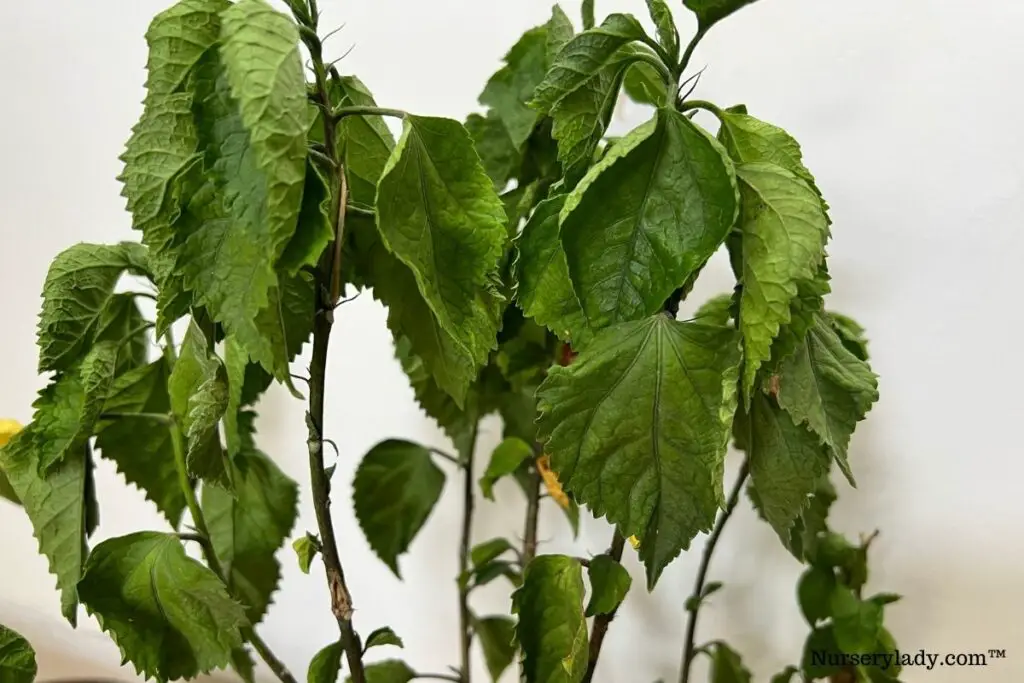
Hibiscus leaves drooping
If you have recently bought a Hibiscus plant, you might be learning about the care tips and the ups and downs the plant might face.
Growing Hibiscus correctly will rarely give rise to any troubles.
But, many beginners will end up watching the plant having droopy leaves.
You should not ignore the problem because the situation can worsen.
In some situations, it is just the beginning of some serious issue.
It could be a serious problem like pests or diseases in other cases.
Whatever it is, you should never neglect it.
Observe closely to identify the crisis and try fixing it as soon as possible.
Below is a list of the probable reasons:
- Poor watering habits
- Poor soil
- Lack of sunlight
- Excessive heat
- Lack of nutrients
- Transplantation shock
- Pests
- Diseases
Now, let’s talk about these reasons in detail and how to deal with them individually.
Poor watering habits
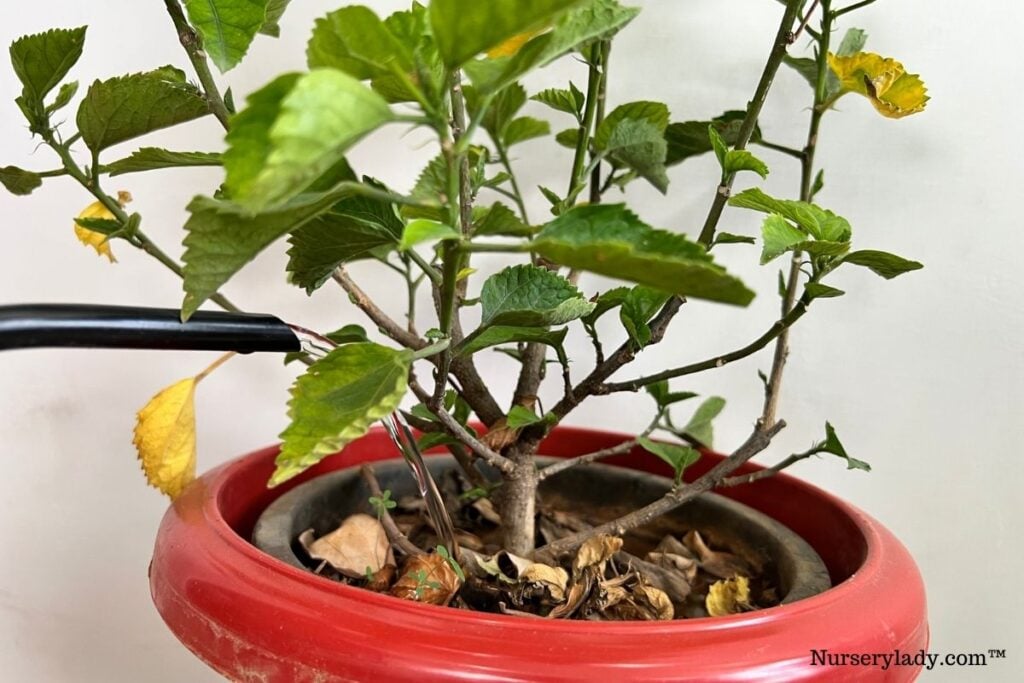
Both overwatering and underwatering will result in limp leaves.
Hibiscus plants are habituated to growing in marshy jungles where the soil remains mostly moist.
It also maintains hydration.
If you don’t give them sufficient water, the leaves will lose their rigidity.
They won’t be energetic enough to remain upright.
Hence, they will droop when they need water.
Consider checking the soil when the leaves are drooping.
If the soil is dry, then the plant requires water.
If not, then the plant is either overwatered or has other issues.
Hibiscus will also have droopy leaves if overwatered.
When you water too much, the roots get suffocated.
Such roots fail to pass on the moisture and nutrients to other plant parts.
The plant doesn’t receive enough water despite having so much.
That is why they will droop due to lack of moisture.
Consider checking the soil to confirm the problem to clarify the cause behind the drooping leaves.
But if the soil is fine, the plant probably has other problems than watering.
How to fix the problem?
- If you haven’t watered your plant for a long time, give the soil a good soak. Water must reach its roots. To confirm that, water your potted plants until the excess water drains out.
- In the case of grounded plants, create a shallow well around the plant base to ensure that the water reaches the 6-inch root.
- If your soil is still wet, but the plant is droopy, it’s overwatering. Don’t water the plant until the soil dries. If you are using a saucer under a potted plant, make sure there isn’t any standing water.
- The container must have drainage holes. If not, either create it or change the container.
- Let the plant have some sunlight to aid in the draining process.
- The best way to improve the watering habits is to check the soil’s moisture level before watering. The plant is ready to take water when the top 1-2 inches are dry.
- If you cannot understand the moisture level, use a moisture meter by poking your fingers inside the soil. If the result is between 1 and 3, the plant is ready to take water. If it is more than 3, wait for some more days to water.
- Sometimes fast-draining or slow-draining soil can cause underwatering and overwatering, respectively. You need to use well-drained loamy soil that can drain and retain well.
Also read: How To Water Hibiscus Plant? (How Much, How Often & More)
Looking for gardening supplies? We have tested 100's of products before recommending them to you guys. Check out our best pick below:
| Image | Gardening Supplies | Best Price? |
|---|---|---|
 Top
Top Top
Top | Raised Garden Bed Kit | Check On Amazon |
 | XLUX Soil Moisture Meter, Plant Water Monitor, Soil Hygrometer Sensor for Gardening, Farming, Indoor and Outdoor Plants, No Batteries Required | No Results |
 Top
Top Top
Top | 82 Pcs Garden Tools Set and Extra Succulent Tools Set | Check On Amazon |
 | Joeys Garden Expandable Garden Hose with 8 Function Hose Nozzle, Lightweight Anti-Kink Flexible Garden Hoses, Extra Strength Fabric with Double Latex Core, (50 FT, Black) | No Results |
 Top
Top Top
Top | Dual Chamber Compost Tumbler | Check On Amazon |
 Top
Top Top
Top | Sunnyglade Plant Stakes | Check On Amazon |
 Top
Top Top
Top | Organic Cold Pressed Neem Seed Oil | Check On Amazon |
 Top
Top Top
Top | Mighty Mint Gallon :-Insect and Pest Control Peppermint Oil | Check On Amazon |
 Top
Top Top
Top | Scotts DiseaseEx Lawn Fungicide | Check On Amazon |
 Top
Top Top
Top | Jacks Classic 20-20-20 All Purpose Fertilizer | Check On Amazon |
 Top
Top Top
Top | 30,000 Seeds Pollinator Attracting Wildflower Mixture | Check On Amazon |
 Top
Top Top
Top | Survival Vegetable Seeds Garden Kit-Over 16,000 Seeds | Check On Amazon |
Lack of sunlight
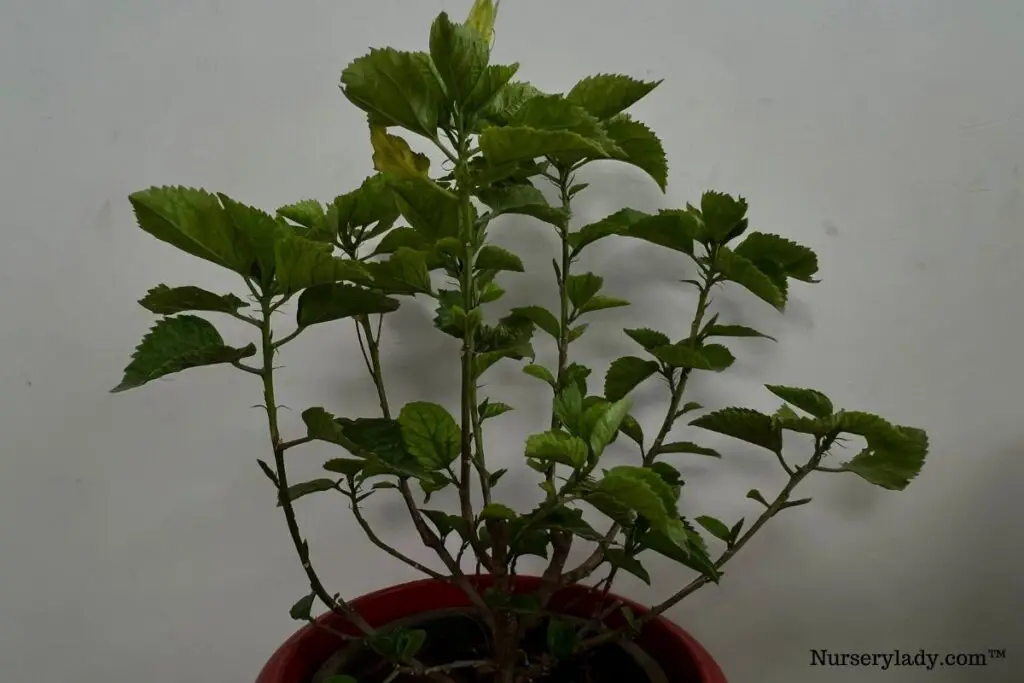
Hibiscus will thrive if it receives daily 6 to 8 hours of sunlight.
Without sunlight, the plant will try to reach some light source and grow in the direction of the sunlight.
It will make them leggy.
On the other hand, the leaves will become droopy due to a lack of sunlight.
They will not be able to get the PAR (Photosynthetic Active Radiation) light from the sun.
Another sign of low light is yellow leaves.
How to improve the lighting conditions?
- You need to shift your plant to a sunny location. It will be easier for the potted plant. But for the grounded plants, you might have to transplant them. If any tall trees are blocking the light, remove them instead.
- During the cloudy days, fix artificial lights for the Hibiscus beds.
- To prevent these troubles, find an ideal location in your garden before planting. Then, plant your Hibiscus at the ideal location. The location must receive 6 to 8 hours of sunlight daily.
- It would be better if there were some trees to shade the Hibiscus because that can reduce sunburns. We will talk about it in the next point.
- If your plant is inside, a south or west-facing window is an ideal direction for enough sunlight.
Also read: How Much Light Does A Hibiscus Plant Need? (What Kind, How Much & More)
Excessive heat
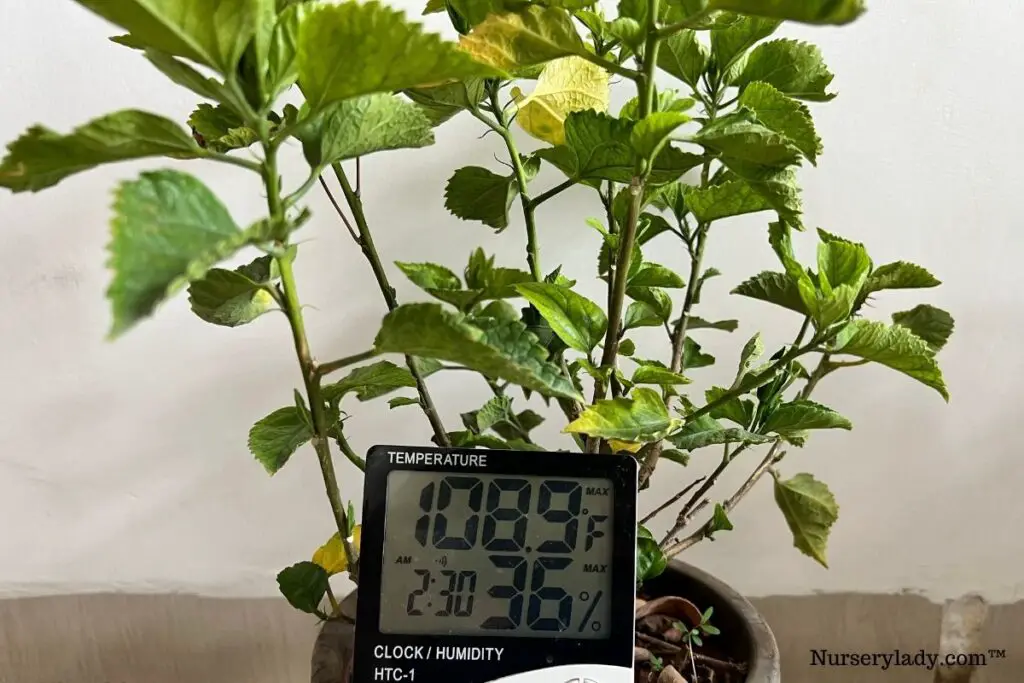
Hibiscus does require a lot of sunlight to thrive, but you should be careful when the climate is too hot.
It increases the temperature and heat intensity of the sunlight.
High temperature and heat can increase the risk of sunburns and overheating, thus causing droopy leaves.
When you use a porous terra cotta container for outdoor Hibiscus plants, the heat enters through the pores of the pot and heats the roots.
Besides droopy leaves, it can cause bud drops and other problems.
How to address the issue?
Make sure the temperature remains between 55 and 75°F.
It shouldn’t go beyond 80-85°F.
Hot temperatures are common in the summers, especially in warm tropical regions.
To fix and prevent droopiness:
- Shade the plant with shading nets partially.
- Shower your plant every week to cool them down.
- If you use a terracotta container, keep it in another pot. Doube-potting will stop the sun’s heat from reaching the roots.
- Increase the watering frequency. In summers, water Hibiscus daily and keep the soil in check. Sometimes the plant might require watering twice a day.
- If your plant is indoors near a south or west-facing window, put on sheer curtains to filter the light in the afternoon, especially in summer.
Also read: Hibiscus Temperature Tolerance: Ideal Range+USDA Zones
Lack of nutrients

Hibiscus plants are heavy feeders, and they need a lot of nutrients to remain healthy.
Without proper nutrition, the plant will become undernourished, and the leaves will become droopy due to weakness.
A lack of nutrients like potassium, zinc, magnesium, iron, etc., will cause droopy leaves.
The minor nutrients are equally important for Hibiscus plants as the three major nutrients.
You shouldn’t use high phosphorus fertilizers.
Excessive phosphate blocks the plant from absorbing other nutrients from the soil.
It results in a lack of nutrients despite proper fertilization.
Giving the plant the right fertilizers will enrich the soil with major and minor nutrients and fix droopiness.
An ordinary soil or fast-draining soil can also lead to under-fertilization.
Ordinary soil will not be fertile for Hibiscus.
If the soil fails to retain well, it won’t hold the nutrients and drain before the plant can absorb them.
It will also make the plant suffer nutrient deficiency.
How to improve nutrition?
- First of all, if you are using a fertilizer high in phosphorus, stop using it. Replace it with the one having medium nitrogen, low phosphorus, and high potassium, for example, an NPK value of 17-5-24.
- Never skip fertilizing in the spring and summer. It boosts their growth and keeps the plant full with fresh and upright leaves. For liquid fertilizer, use it every 2 weeks throughout the growing season.
- If your plant lacks micronutrients like zinc, magnesium, or iron, use a product called Agromin Gold. It will give the plant all the micronutrients if your fertilizer doesn’t have them or the plant couldn’t get them due to high phosphorus.
- Add a few inches of compost as mulch to improve the fertility of the soil.
- Make sure the soil can retain the nutrients you provide.
Also read: What Is A Good Fertilizer For Hibiscus Plants? (Ideal Ratio+Best Pick)
Transplant shock
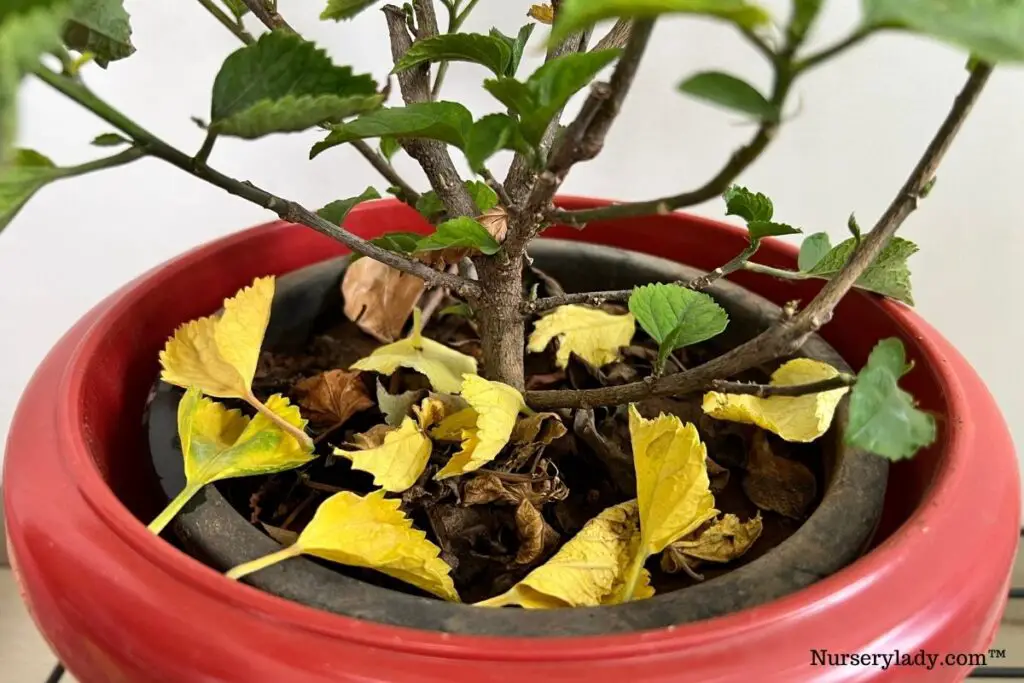
Hibiscus plants are a little sensitive to sudden changes.
Hibiscus will face transplant shock in certain situations like:
- Transplanting seedlings to the outdoor location
- Repotting
When you grow Hibiscus from seeds, most people start indoors and transplant them outdoors when they become seedlings.
Before transferring, you must let the seedling harden.
They grew up in a controlled environment and won’t easily adjust to the outdoor environment.
The leaves will begin to droop due to stress.
The same thing happens with repotting.
The plant faces a change while repotting new soil from one container to another.
This change will stress the plant and result in limp leaves.
Drooping due to these changes is the plant’s way of reacting to stress.
They go through a shock when they shift from one location to another.
The leaves sometimes also turn yellow or brown and fall off.
There is no such solution to it.
The only thing you need to do is be gradual and take care of the plant without stressing them.
Once it adjusts itself to the new environment, the leaves will become normal.
Pests
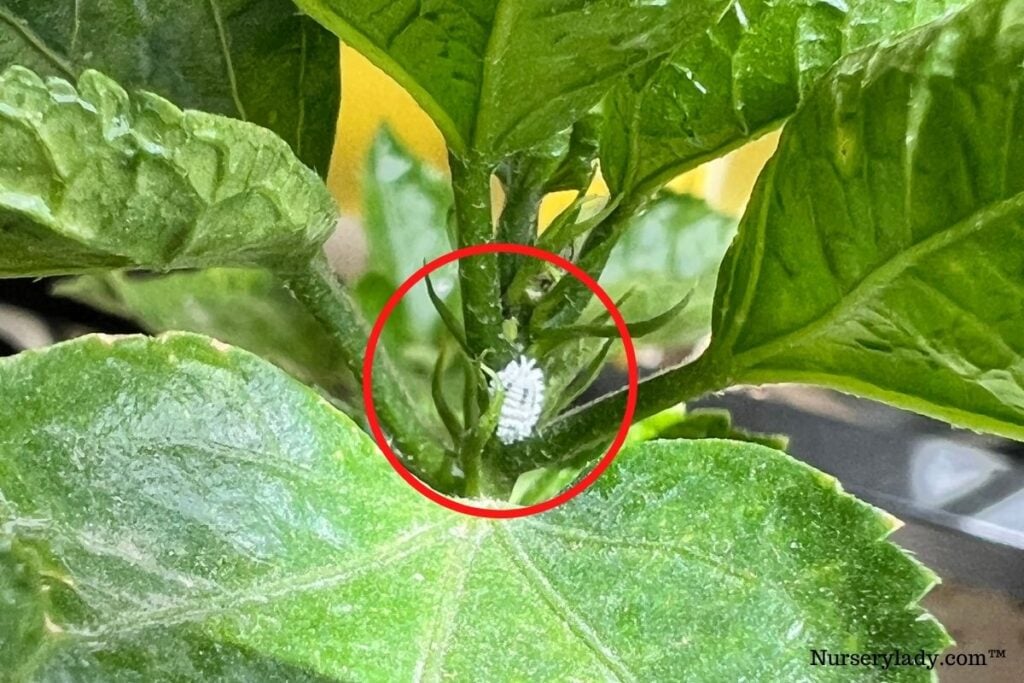
Pests like aphids, spider mites, scales, mealybugs, and whiteflies are responsible for droopy leaves.
These sap-sucking insects suck all the saps of the xylem and phloem.
The leaves lose their energy to remain fresh and upright due to the lack of these saps and become droopy.
Over time, the leaves will become yellow or brown and ultimately fall off the plant.
How do I get rid of pests?
- Imidacloprid will help to get rid of all the sap-suckers. Spread it and let the soil absorb it. When the insects again suck the saps, they will absorb the chemical and die.
- Spray Neem oil on the infected area. Apply neem oil when the sun goes down; otherwise, direct sunlight can burn the sprayed leaves.
- Use insecticidal soaps and coat the insects to block their oxygen and kill them.
- Use insecticides containing Acephate and Di-Syston.
Also read: Hibiscus Temperature Tolerance: Ideal Range+USDA Zones
Diseases
Diseases, too, will weaken the plant and result in limp leaves.
But one particular disease called Wilt disease will result in drooping leaves.
You can identify the fungal disease when you see that all the green leaves have suddenly wilted and drooped down.
It is generally caused due to prolonged damp conditions and unnecessary wounds.
The fungus finds its way into the wound and enters the plant.
How to remove the disease?
- While watering, avoid splashing the leaves.
- Remove the infected discolored parts as soon as possible. Don’t remove the green leaves even if they are droopy.
- Try to shade the plant for some days until recovery.
- Check the soil. If the wilt has caused due to drought conditions, watering the plant will solve the problem. But if it’s damp, it is the disease, and you need to act quickly.
- Keep the containers and the surrounding environment neat and clean, and never overwater your plant again.
- Don’t transplant or prune now. To prevent this later, avoid unnecessary wounds during transplantation or pruning.
- Don’t water the plant until the soil has dried up.
- Mist the leaves to keep them hydrated. Misting will hydrate the leaves and help them come back to life.
- Use a growth enhancer to keep your Hibiscus strong and immune to fight the disease.
- Avoid over-fertilization. Don’t fertilize in dry soil. Always moisten the soil before feeding.
- Within 2-3 weeks, the leaves will crisp back, and the plant will have new green leaves.
Final thoughts
Drooping Hibiscus leaves doesn’t mean your plant is dying. If you detect the right problem in time, you can save the plant by acting quickly.
Give them 6-8 hours of sunlight. Protect them from excess heat when the temperature rises above 85-95°F. Water when the top 1-2 inches have dried. If you are inexperienced, use a moisture meter.
Fertilize Hibiscus in the spring and summer with the correct type of fertilizer.
Let the seedling harden before transplanting it outside. During repotting, give the plant time to adjust to the new environment. Don’t stress them further.
Watch out for pests and diseases and take immediate action without delay. If you follow the instructions in this article, your leaves will come back fresh and green from droopiness and dullness within a few weeks.
Reference: Wikipedia, ASPCA, Louisiana State University Agricultural Center, American Society for Horticultural Science, Tropical Hibiscus by Texas A&M University, Sciencedirect.
